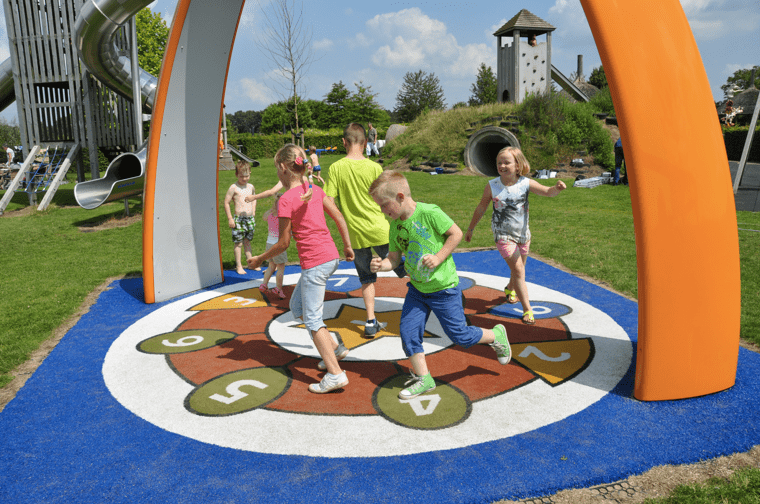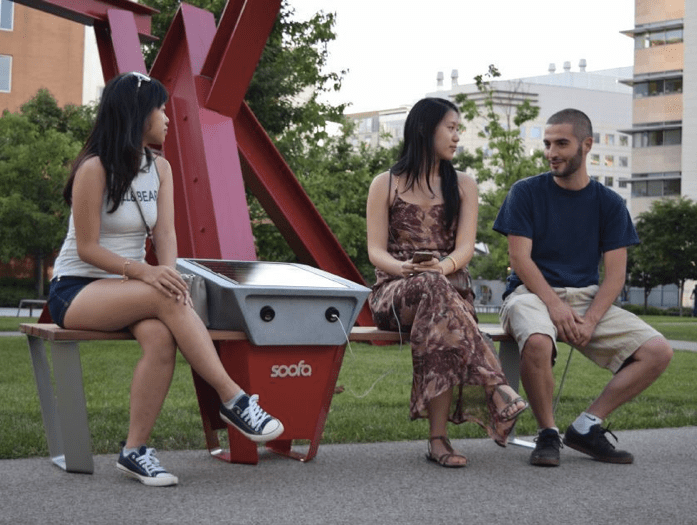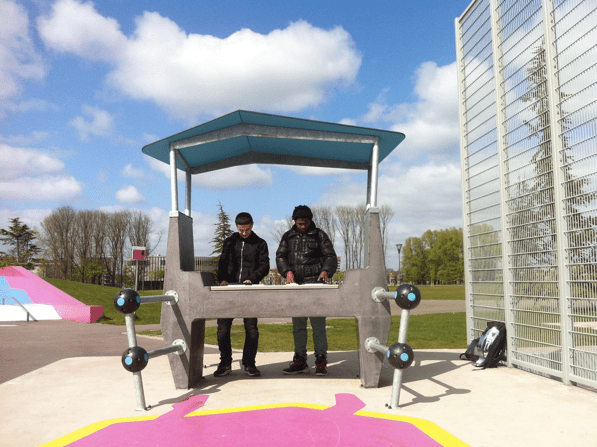The Smart Cities Toolkit for SMART Urban Parks

Who will you meet?
Cities are innovating, companies are pivoting, and start-ups are growing. Like you, every urban practitioner has a remarkable story of insight and challenge from the past year.
Meet these peers and discuss the future of cities in the new Meeting of the Minds Executive Cohort Program. Replace boring virtual summits with facilitated, online, small-group discussions where you can make real connections with extraordinary, like-minded people.
Public parks have been a central facet of urban life for more than 100 years. During that time, technology has become integral to our lives – when traveling, at work, at home, and at play. However, technology has not historically been used in park settings. The UCLA Luskin Center for Innovation’s recently released SMART Parks Toolkit empowers city planners, designers, and park managers to change that in order to better serve communities.

Credit: Nick Cuccia
SMART Parks use technology (environmental, digital, and materials) to reflect and fit within their cultural and environmental surroundings, are easily accessible, are resilient to climate change, are water- and energy-efficient, are easy to maintain, and help promote the health and safety of communities.
While some parks already achieve these goals, many fall short, especially in urban centers. Parks, most of which are owned and managed by cities, face challenges ranging from underutilization to lack of resources, such as funding for maintenance, staff, and programming community services. The Luskin Center’s SMART Parks Toolkit provides numerous examples of technologies that can help park management address these obstacles by category: landscape, irrigation, stormwater, hardscape, activity spaces, urban furniture and amenities, lighting, and digital landscapes.
For example:
- Smart irrigation controllers can determine the optimal amount of watering needed, based on weather patterns and soil conditions, thus reducing water use and maintenance costs.
- Interactive play structures use customizable software to meet community needs based on language and cultural background. They can also provide amenities accessible to disabled children.
- Energy-generating exercise equipment not only can improve community health, but also produces clean energy for use onsite.
- Automatic lawn mowers can save staff time and reduce emissions associated with typical gas-powered lawn mowers.
- Lighting improvements, such as walking paths that glow in the dark, can increase the appeal and safety of parks, thus encouraging a sense of security and therefore, visitation.

Credit: Yalp Interactive
The toolkit can be a good resource for folks interested in implementing just one technology or it can serve as a foundation for long-term land use planning. It recommends investigating which and how many products are most appropriate for each particular park and community.
How to Create SMARTer Parks
The toolkit is designed for city and park managers, advocates, and anyone interested in utilizing technology in parks. In addition to providing example technologies, the toolkit rates each one based on how it impacts health, community access, water efficiency, and a number of other criteria, includes tips for implementation, as well as presents creative ideas for establishing partnerships and funding strategies.
Cutting park maintenance costs
Technology options range in cost, and park managers can select those that meet their budget and goals. Technological upgrades do not need to be implemented on a large scale to be impactful. Small-scale and relatively “low-tech” technologies, such as air-pruning plant containers that encourage healthy root growth before permanent planting or rainwater harvesting that captures, diverts, and stores rainwater for landscaping, can be low-cost and effective at helping park management meet visitor needs.

Credit: W.S. Cumby Builders & Construction Managers
Because parks are typically run by public agencies that are often risk-averse, pilot projects can be a great way to test the effectiveness and value of a technology. A small-scale test that proves effective could help management make a case for a larger roll-out of the technology later.
Covering the cost of upgrades
No matter the scale, investing in new technologies requires resources, which are often scarce. Thus, it is imperative to think creatively about how to secure funding to invest in technology to create SMART Parks. The Luskin toolkit provides information on establishing partnerships (public-public, public-private, and public-nonprofit) as well as securing grants, loans, rebates, bonds, and other funding resources.
Partnering to implement technology in parks is critical.
Public-public partnerships, such as those between park and other city departments can help leverage resources and cost-effectively meet common goals. Many cities have created new offices focused on technology use, such as the City of Sacramento’s Office for Innovation & Entrepreneurship created to develop, test, deploy and scale new technologies. These departments could be valuable partners and provide funding to park departments to create SMART Parks.
Private-public partnerships can offer startups and technology companies a chance to test or pilot new technologies and park management an opportunity to provide a new service for the community. For example, when Soofa first launched their Soofa Bench in Boston in 2014, they provided technical and maintenance assistance to all early adopters. The benches collect park visitor data which park management can use to inform decision-making. In Oak Park, Illinois, the parks department installed 4 benches in 2016. Bobbi Nance, Senior Manager of Strategy and Innovation at the Park District reported “starting to see how park visitation is impacted by rentals, holidays, weather, construction, as well as the number of attendees at a special event or number of people that take advantage of temporary offerings like outdoor ice rinks or art installations.” Soofa continues to provide services to all their customers to assist with implementation and data analysis.

Credit: Soofa
Public-nonprofit partnerships can enable park departments to access funds only available for nonprofits, including large organizations, grassroots community groups, and research universities. Not only are nonprofits eligible to apply to foundations and can attract individual donors, but also they can supplement park annual operating budgets, establish endowments, or implement new community projects. For example, the UCLA Research in Engineering, Media and Performance (REMAP) Center partnered with California State Parks to develop and implement technology in the Los Angeles State Historic Park. The effort was part of a larger research initiative on cultural civic computing, a concept coined by REMAP, to consider computers in public spaces in the service of community (as opposed to personal computing).
Meeting community needs
Technology can be used in urban parks in two distinct ways: to improve operational efficiency and/or to enhance community services.
- To improve management efficiency, reducing resource use and costs, such as with self-healing concrete – a new material that is traditional concrete mixed with bacteria that can “heal” cracks in infrastructure.

Credit: CNN
- To enhance community services, such as by providing free Wi-Fi access, restroom occupancy sensors, or outdoor DJ booths, thus drawing a wider range of visitors to parks.

Credit: Yalp Interactive
Different technologies are appropriate in different park settings. Management can (and should!) work with the surrounding community to identify gaps in services and to develop technological solutions collaboratively. The Luskin Center’s toolkit, which was made possible by the generous support of The Rosalinde and Arthur Gilbert Foundation, is an excellent resource to help determine the most appropriate technologies for parks and how best to implement them.
Discussion
Leave your comment below, or reply to others.
Please note that this comment section is for thoughtful, on-topic discussions. Admin approval is required for all comments. Your comment may be edited if it contains grammatical errors. Low effort, self-promotional, or impolite comments will be deleted.
6 Comments
Submit a Comment
Read more from MeetingoftheMinds.org
Spotlighting innovations in urban sustainability and connected technology
Middle-Mile Networks: The Middleman of Internet Connectivity
The development of public, open-access middle mile infrastructure can expand internet networks closer to unserved and underserved communities while offering equal opportunity for ISPs to link cost effectively to last mile infrastructure. This strategy would connect more Americans to high-speed internet while also driving down prices by increasing competition among local ISPs.
In addition to potentially helping narrow the digital divide, middle mile infrastructure would also provide backup options for networks if one connection pathway fails, and it would help support regional economic development by connecting businesses.
Wildfire Risk Reduction: Connecting the Dots
One of the most visceral manifestations of the combined problems of urbanization and climate change are the enormous wildfires that engulf areas of the American West. Fire behavior itself is now changing. Over 120 years of well-intentioned fire suppression have created huge reserves of fuel which, when combined with warmer temperatures and drought-dried landscapes, create unstoppable fires that spread with extreme speed, jump fire-breaks, level entire towns, take lives and destroy hundreds of thousands of acres, even in landscapes that are conditioned to employ fire as part of their reproductive cycle.
ARISE-US recently held a very successful symposium, “Wildfire Risk Reduction – Connecting the Dots” for wildfire stakeholders – insurers, US Forest Service, engineers, fire awareness NGOs and others – to discuss the issues and their possible solutions. This article sets out some of the major points to emerge.
Innovating Our Way Out of Crisis
Whether deep freezes in Texas, wildfires in California, hurricanes along the Gulf Coast, or any other calamity, our innovations today will build the reliable, resilient, equitable, and prosperous grid tomorrow. Innovation, in short, combines the dream of what’s possible with the pragmatism of what’s practical. That’s the big-idea, hard-reality approach that helped transform Texas into the world’s energy powerhouse — from oil and gas to zero-emissions wind, sun, and, soon, geothermal.
It’s time to make the production and consumption of energy faster, smarter, cleaner, more resilient, and more efficient. Business leaders, political leaders, the energy sector, and savvy citizens have the power to put investment and practices in place that support a robust energy innovation ecosystem. So, saddle up.






I would like to express the lack of open space equity in urban communities economically and academically challenged face the worst discrimination on funding from the public, private and philanthropic partnerships to accomplish this great effort. The lack of technical capacity and knowledge on how to get started and pitch the concept of transforming a highway by decking and building a park above it becomes overwhelming to its residents and government. Any thoughts?
The Los Angeles Parks Foundation was created in 2008 to enhance, expand, preserve and promote recreation, parks and open space for the people of Los Angeles. We fulfill our mission by raising private funds to supplement public project funding. We have raised over $25 million to support City of LA park projects and programs. Please visit our website at http://www.laparksfoundation.org to learn more or contact us at anytime. I also encourage you to learn more about The City Parks Alliance which is the only national urban parks organization located in Washington, DC. I am pleased to serve on that board.
Thank you.
While some Smart City solutions have great potential to address key challenges in urban areas, not everything that can be digitized or equipped with technology, should be. Some of the technologies presented in the Toolkit make sense from a parks management perspective (e.g. the use of smart irrigation systems), whereas others such as the data-collecting Soofa Bench seem to provide little added value compared to a ‘dumb’ park bench which is also less expensive and easier to maintain.
Along similar lines, the economic rationale behind some of the products outlined in the Toolkit are not very straightforward, particularly taking into account that some of the services are already provided by nature, e.g. by bees and trees. While they might be less effective and efficient than the vibrating pollinators and solar shade structures, they provide their various ecosystem services for free.
In addition, this very technocentric view of urban parks seems to undermine one of the main reasons for their very existence, namely to provide urbanites with an opportunity to connect with nature close to where they live. It’s hard to imagine a rejuvenating walk in the park with loud music blasting from a DJ booth.
Here is our take on Smart Urban Parks: http://talkofthecities.iclei.org/wiring-trees-smart-urban-parks-are-missing-the-point/
Thank you to Olga Horn for the comment. I agree that it is critical to have thoughtful conversations about whether or not (and which) technologies should be used in parks and appreciate the points Ms. Horn raised. The Luskin Center’s SMART Parks: A Toolkit features a range of different technologies and focuses on their potential benefits. However, the authors, myself included, agree that technology is not appropriate in all settings. As we describe at length in the toolkit, each park has its own unique context and it is up to the managers, designers, and other stakeholders to work with the surrounding community to identify if technology is a good fit to help them meet their goals, and if so, which technologies will be most appropriate.
Many parks are underutilized today; often due to generic design or design that is not reflective of the specific needs and desires of the neighborhood. Technology is one tool that can help park professionals make their parks more dynamic and appealing to a wider array of visitors. Instead of playing video games in their rooms, perhaps teenagers will be more likely to visit an outdoor DJ booth or an interactive play structure, both of which can be programmed to meet the needs of the neighborhood. For example, the DJ booth can be set to only activate during special events or at certain times of the day.
While technology will not be appropriate in all settings, it can be extremely beneficial in some. It is up to the park managers, designers, and advocates to determine the park context and most appropriate tools for meeting their visitors’ needs.
I welcome further discussion on this. You can follow up with me at kjessup@luskin.ucla.edu.
As society moves towards having (possibly needing to have) a digital twin I very much welcome the work here to converge a sector that has sometimes been looked down on with technology. 5G and local wifi will be of help here.
In the UK we are benefitting from some of the advances you have shown here as well as hopefully adding some of our own. I’d like to encourage your supporters to continue sharing and building on your work worldwide so that we can push forward together on this. May I suggest Twitter as a mechanism and #smartparks as a hashtag for doing so, perhaps?
Hello from Spain. In Zaragoza (700.000 inhabitants), there is a new big park (120 Ha.) built in 2008. The shrinking budgets change the way of management into a very ecological smart park. Zero pesticides, flock of sheep that take advantage of grass in wild areas and attract visitors, insects hotels, breeding close areas for wild fauna and many other actions , natural cleaning water system or horses that give you tours inside the park and you use the manure to fertilize after the gardens.
All theses things made it possible to manage with 30% less budget.
http://www.smarturbanparks.com makeit possible